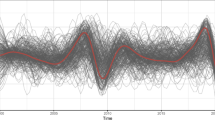Abstract
There is an ongoing trend of deregulation and integration of electricity markets in Europe and North America. This change in market structure has naturally affected the interaction between agents and has contributed to an increasing commoditization of electric power. This paper focuses on one specific market, the Iberian electricity market (MIBEL). In particular, we assess the persistence of electricity prices in the Iberian market and test whether it has changed over time. We consider each hour of the day separately, that is, we analyze 24 time series of day-ahead hourly prices for Portugal and another 24 series for Spain. We find results consistent with the hypothesis that market integration leads to a decrease in the persistence of the price process. More precisely, the tests detect a break in the memory parameter of most price series around the year 2009, which coincides with a significant increase in the integration of the Portuguese and Spanish markets. The results reinforce the view that market integration has an impact on the dynamics of electricity prices.








Similar content being viewed by others
Notes
Further details at http://www.epexspot.com/en/market-coupling.
PJM Interconnection is a regional transmission organization that coordinates the movement of wholesale electricity in Delaware, Illinois, Indiana, Kentucky, Maryland, Michigan, New Jersey, North Carolina, Ohio, Pennsylvania, Tennessee, Virginia, West Virginia, and the District of Columbia.
Price data for both markets are available at www.omip.pt.
Note, however, that the actual capacity of the transmission lines is a function not only of the nominal transmission capacity, but also of several constraints, such as air temperature or the state of the each countries’ own transmission network. Furthermore, the programmed availability of renewable energies also has an effect on the maximum transmission capacity the TSOs make available.
Hourly generation data were provided by REN.
We have also considered the case where a linear trend is included and the results are qualitatively similar.
References
Alvarez-Ramirez J, Escarela-Perez R (2010) Time-dependent correlations in electricity markets. Energy Econ 32:269–277
Andrews DWK (1993) Tests for parameter instability and structural change with unknown change point. Econometrica 61:821–856
Bai J, Perron P (1998) Estimating and testing linear models with multiple structural changes. Econometrica 66:47–78
Bai J, Perron P (2003) Critical values for multiple structural change tests. Econom J 6:72–78
Bosco B, Parisio L, Pelagatti M, Baldi F (2010) Long-run relations in European electricity prices. J Appl Econom 25:805–832
Breitung J, Hassler U (2002) Inference on the cointegration rank in fractionally integrated processes. J Econom 110(2):167–185
Cecchetti SG, Flores-Lagunes A, Krause S (2006) Has monetary policy become more efficient? A cross-country analysis. Econ J 116(511):408–433
Demetrescu M, Kuzin V, Hassler U (2008) Long memory testing in the time domain. Econom Theory 24:176–215
Elliott G, Müller UK (2007) Confidence sets for the date of a single break in linear time series regressions. J Econ 141(2):1196–1218
Haldrup N, Nielsen MØ (2006) A regime switching long memory model for electricity prices. J Econom 135:349–376
Haldrup N, Nielsen FS, Nielsen MØ (2010) A vector autoregressive model for electricity prices subject to long memory and regime switching. Energy Econ 32(5):1044–1058
Halunga AG, Osborn DR, Sensier M (2009) Changes in the order of integration of US and UK inflation. Econ Lett 102:30–32
Hassler U (2012) Impulse responses of antipersistent processes. Econ Lett 116(3):454–456
Hassler U, Meller B (2014) Detecting multiple breaks in long memory: the case of US inflation. Empir Econ 46:653–680
Hassler U, Rodrigues PMM, Rubia A (2009) Testing for the general fractional integration hypothesis in the time domain. Econom Theory 25:1793–1828
Herrera AM, Pesavento E (2005) The decline in US output volatility: structural changes and inventory investment. J Bus Econ Stat 23(4):462–472
Kang KH, Kim CJ, Morley J (2009) Changes in U.S. inflation persistence. Stud Nonlinear Dyn Econom 13:1–21
Koopman SJ, Ooms M, Carnero MA (2007) Periodic seasonal Reg-ARFIMAGARCH models for daily electricity spot prices. J Am Stat Assoc 102(477):16–27
Martins L, Rodrigues PMM (2014) Testing for persistence change in fractionally integrated models: an application to world inflation rates. Comput Stat Data Anal 76:502–522
McConnell MM, Perez-Quiros G (2000) Output fluctuations in the United States: what has changed since the early 1980s? Am Econ Rev 90:1464–1476
Robinson PM (1994) Efficient tests of nonstationary hypotheses. J Am Stat Assoc 89:1420–1437
Schwert GW (1989) Tests for unit roots: a Monte Carlo investigation. J Bus Econ Stat 7:147–159
Tanaka K (1999) The nonstationary fractional unit root. Econom Theory 15:549–582
Weron R (2002) Measuring long range dependence in electricity prices. In: Takayasu H (ed) Empirical science of financial fluctuations. Springer, Tokyo, pp 110–119
Weron R (2014) Electricity price forecasting: a review of the state-of-the-art with a look into the future. Int J Forecast 30(4):1030–1081
Acknowledgements
We thank REN for providing data on Portuguese power generation. We are also grateful to an Associate Editor and two anonymous referees for useful comments and suggestions.
Author information
Authors and Affiliations
Corresponding author
Rights and permissions
About this article
Cite this article
Pereira, J.P., Pesquita, V., Rodrigues, P.M.M. et al. Market integration and the persistence of electricity prices. Empir Econ 57, 1495–1514 (2019). https://doi.org/10.1007/s00181-018-1520-x
Received:
Accepted:
Published:
Issue Date:
DOI: https://doi.org/10.1007/s00181-018-1520-x



